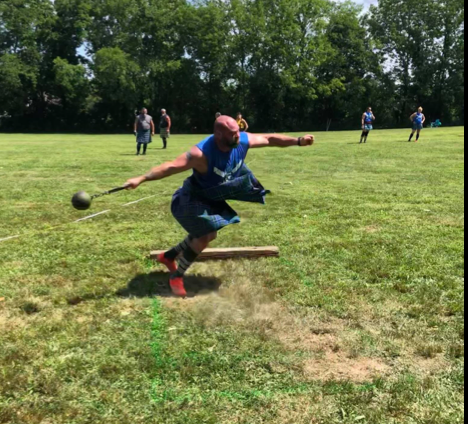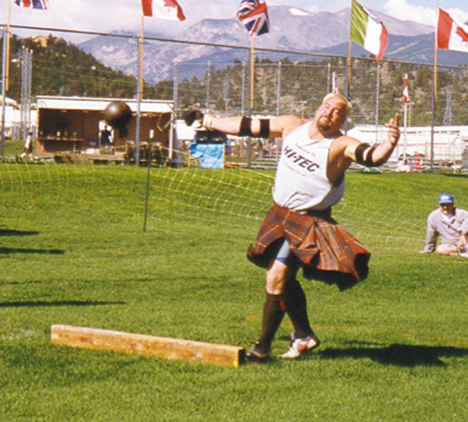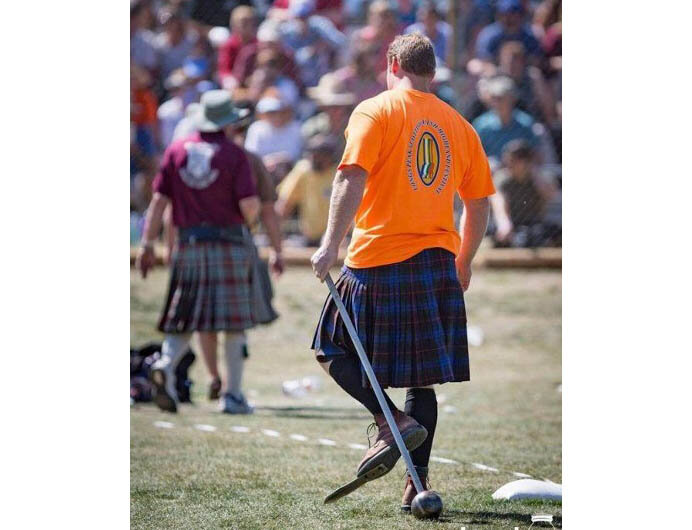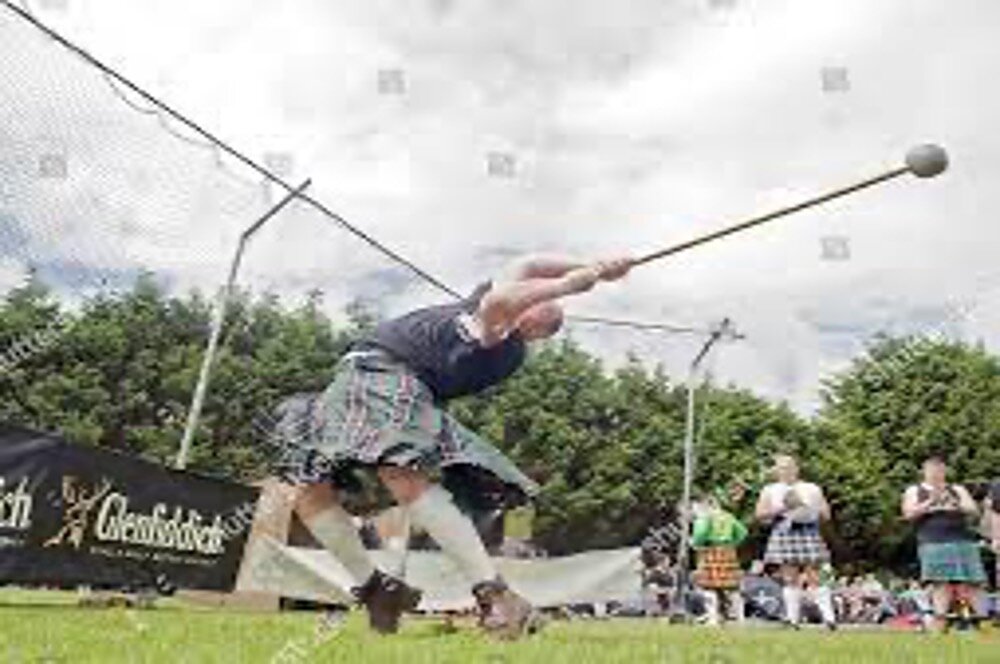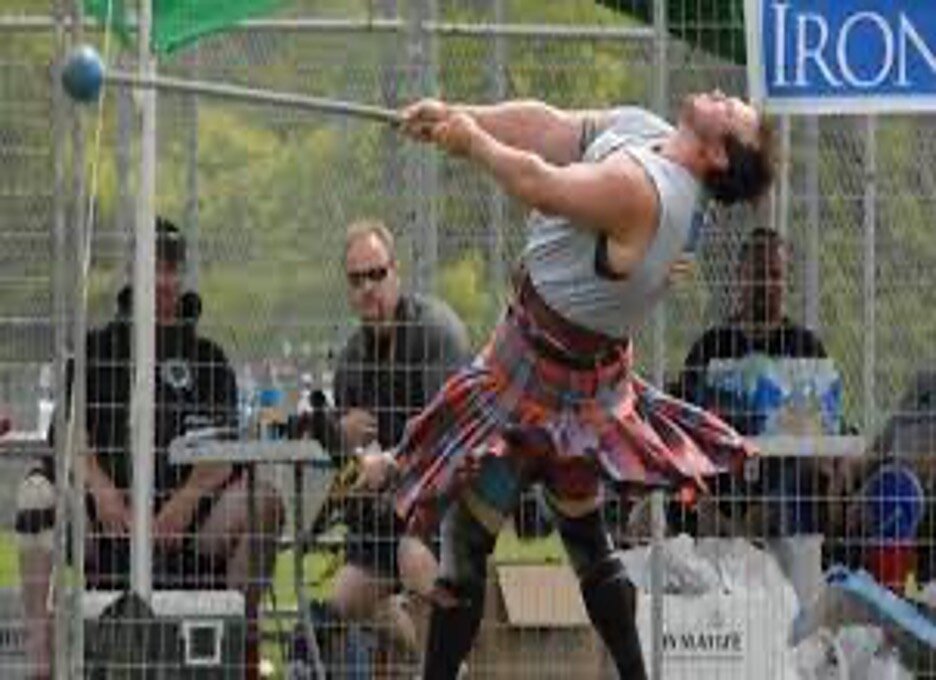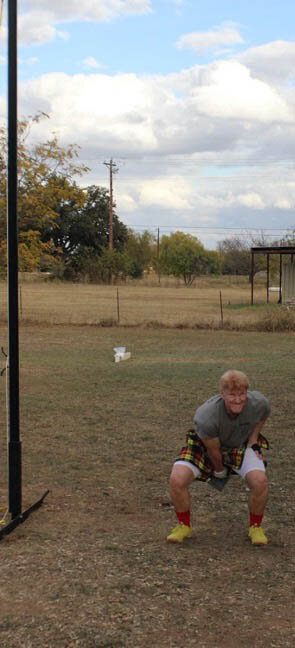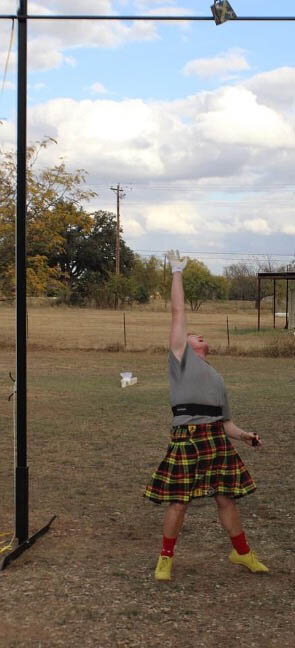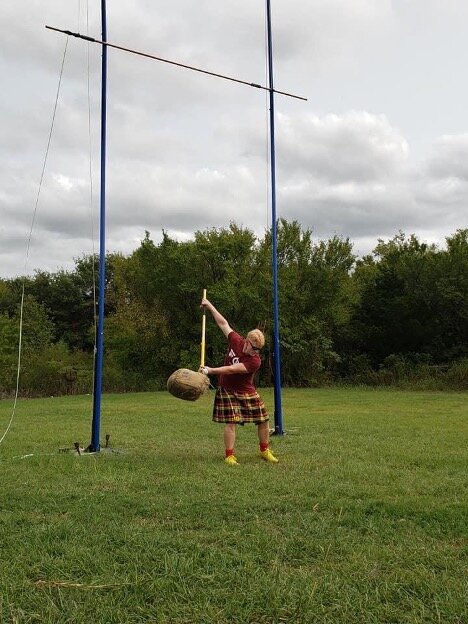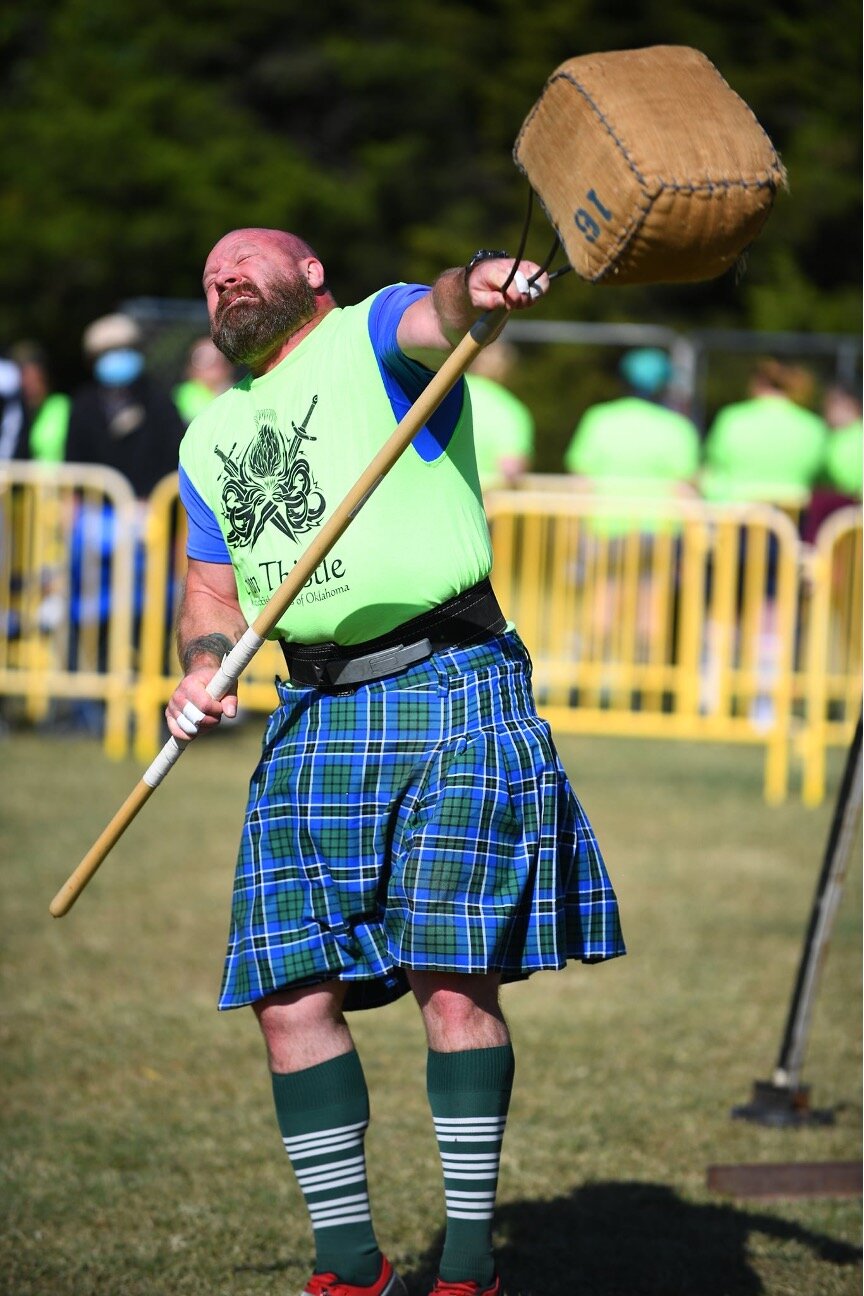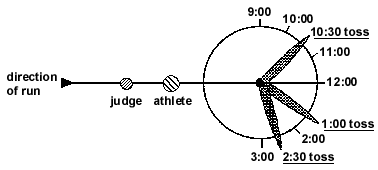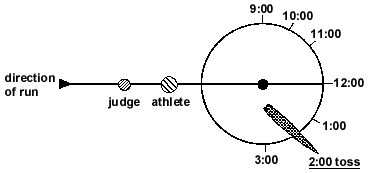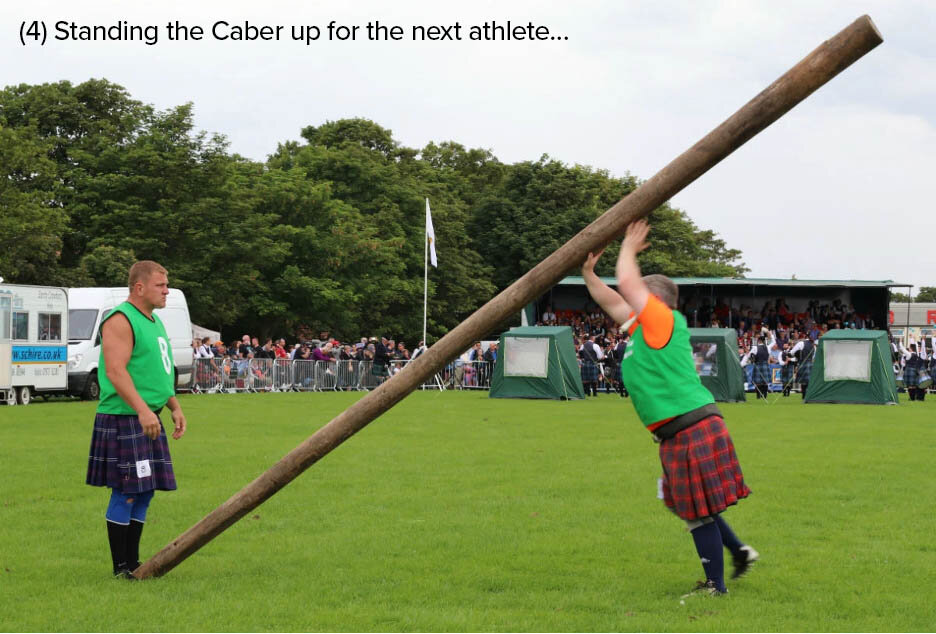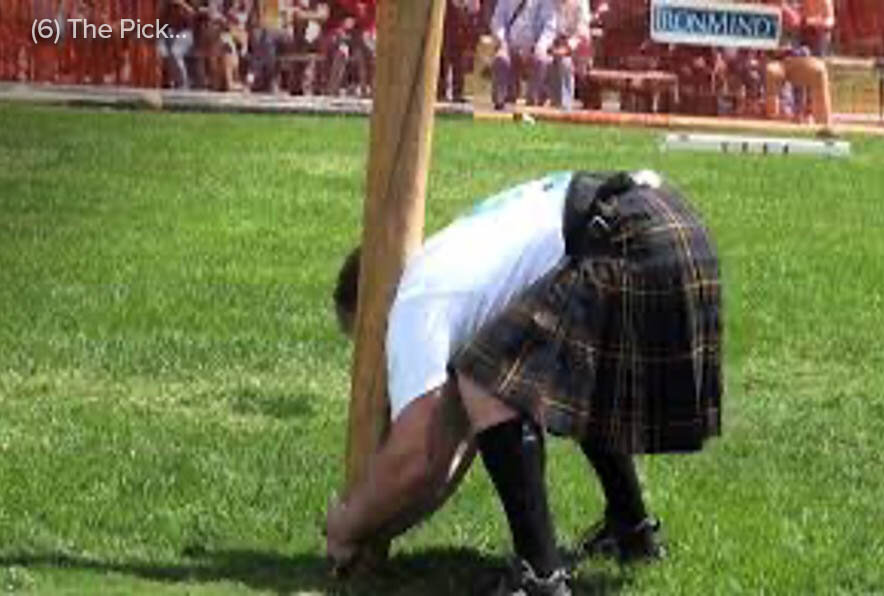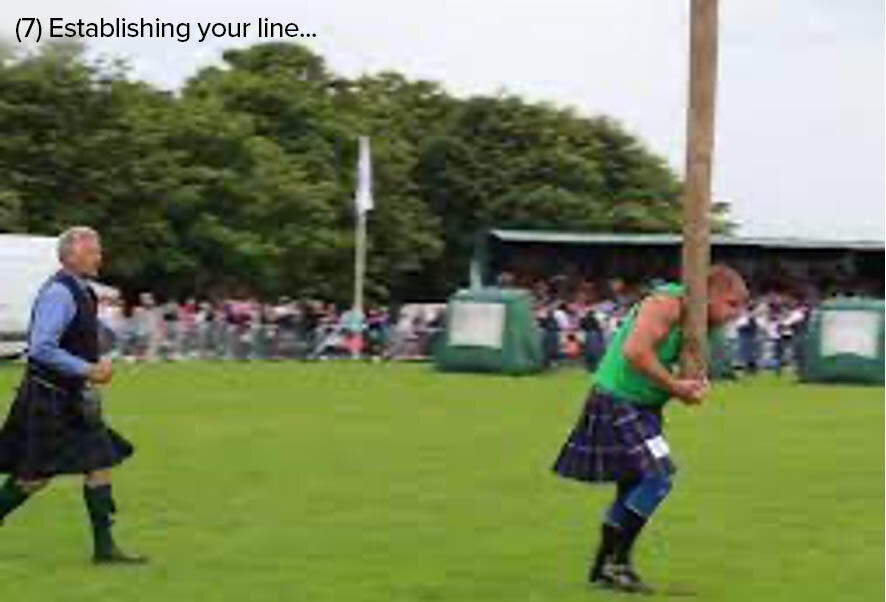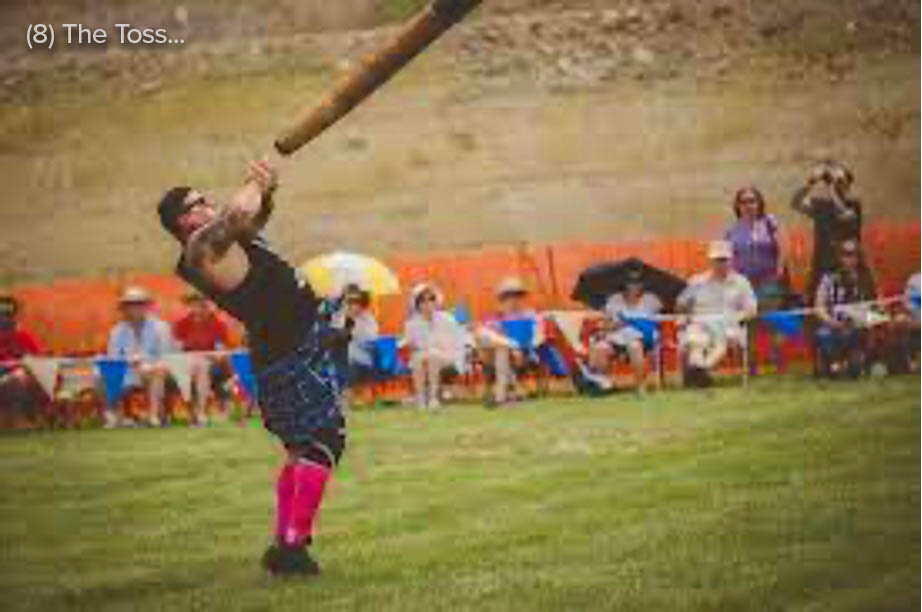H I G H L A N D G A M E S
Where did Highland games come from?
It may be impossible to say where it all started. Men have been competitive since the beginning of time. One myth says the events were started as training for war. Other people say that they were based on implements people found around a farm and as people are want to do… who can throw something the farthest or highest.
Through time they have been narrowed down to nine events that comprise the modern Highland games:
Weights for distance (Heavy and Light)
Hammers (Heavy and Light)
Regardless of where you compete there are a few things that are universal:
The competitors must wear kilts.
The throwing area for distance events is standardized.
The throwing area has a board called a “trig” at the front. A standard straight trig is 4’6” or 1.37m wide.
The competitor must have his feet behind the trig at all times.
There is a backline that must not be crossed.
For stone events the backline is 7’6” or 2.28m from the trig.
Weights for distance have the backline 9’0” or 2.74m from the trig.
Hammers have the trig, but as you are not allowed to move your feet during the throw the backline is irrelevant.
Height events have a crossbar that is generally 10’ or 3.04m wide attached to uprights. The object thrown must clear the crossbar between the uprights.
Getting started
How do I get into Highland Games?
How do I train?
Where are the competitions?
These are questions everyone asks when they first get interested. I can tell you from personal experience that I had never heard of Highland Games until my future wife took me to a Scottish festival. Even though it was cold, rainy and miserable weather, watching the athletes made me wonder could I do that? Could I beat that guy? I walked up to a competitor to ask how to get started. He answered: ”You on Facebook?” In America Facebook is how the athletes and organizations communicate. There are groups in all areas of the country that disseminate the information. They are easy to find. You can also search for Scottish or Celtic festivals. Likely the same is true in other parts of the world with minimal effort.
Another great resource is YouTube. I have attached links in each section below showing a great example of how the throw is done and a more instructional video to get you started. Again, with a little effort you can find a wealth of information to help you.
Why should I participate in Highland Games?
…because it is fun. The people I have met along the way have all been great. Everyone tends to help everyone. At almost every game I have been to there has been someone for whom that was their first game. Few people will be pros… the competition is with yourself. The camaraderie among the athletes is outstanding.
People love the kilts… and who doesn’t want to impress their friends by saying they tossed a tree?
Let’s start looking at the different events:
Braemar stone
The Braemar stone is a standing put (throw) named after the Braemar gathering in 1715 at Castle Mar in Scotland. The Braemar is an actual stone, weighting between
Men: 20-26lbs (9-11.8kg)
Women: 13-18lbs (5.8-8.2kg)
The thrower is not allowed to move his feet during the throw, but can reverse his feet with the momentum of the throw. During a competition a competitor will get three attempts to put the stone as far as possible. The throw is measured from the center front of the trig to the closest indention of the stones initial landing point. A competitor’s best throw is recorded.
Open Stone
The open stone is similar to the Braemar in that the athlete holds the stone in one hand against the neck until the release. Unlike the Braemar the open stone allows the competitor to move his feet.
The athlete have 7’6’’ (2.2m) from the backline to the trig to move.
The width is the same 4’6” (1.3m).
There are several styles and the athlete must find the one that works best for him. There is the full spin, the modified South African, the glide and the shuffle. In all of these the athlete uses his momentum to add force to his throw. At the moment of the throw the athlete’s feet should end up in the same position as the Braemar to use his legs as the power of the throw.
The open stone weight is slightly less than the Braemar making it easier to move. Men’s open stone typically weights 16-22lbs (7.2-9.9kg) and the women use a 8-12lbs (3.6-5.4kg).
Weights for Distance
No surprise…weight for distance is just that: who can throw the weight the farthest.
The athlete can only use one hand to throw the weight.
The weight is metal, but can come in various shapes: spherical, bullet, box or anything else.
Attached to the weight is a short chain with a handle
The handle can also be various shapes: ring, triangle or D-shape
The total length must not exceed more than 18” or 45.7cm
The weights are broken down into light and heavy and by sex/age. Usually both LWFD (lightweight for distance) and HWFD (heavyweight for distance) will be competed at a game.
Men 28lbs (12.7kg) and 56lbs (25.4kg)
Women 14lbs (6.3kg) and 28lbs (12.7kg)
Masters Men (over 40’s)28lbs (12.7kg) and 42lbs (19.0kg)
Masters Women (over 40’s) 14lbs (6.3kg) and 21lbs (9.5kg)
The athlete may use any style, but most throwers use one or two “turns”, i.e., spinning as they also move from the back of the box to the front to add momentum and force to their throw. The athlete may start and/or end with one foot outside the box, but may step on the back line or the trig.
Hammer
The Scottish hammer is a metal ball attached to a solid shaft.
The shaft may be wood or, more commonly PVC pipe. The overall length shall be no longer than 50in (127cm).
The hammer comes in two weights light and heavy. Normally, both will be thrown at a game, but you may often find that only one is being thrown due to space or time. Standard weight shall be:
Men 16lbs (7.25kg) and 22lbs (9.97kg)
Women 12lbs (5.44kg) and 16lbs (7.25kg)
The hammer is thrown with the athlete’s back to the field. The hammer is swung over the athlete’s head and released over their shoulder in the field. The athlete may not move his feet during the swing, but may as the hammer is released.
You will frequently see athlete’s wearing shoes with metal blades attached to the sole and protruding from the front. These blades or “murder boots” are used to anchor the athlete’s feet to the ground. This allows them to use their hips more and lay back into the winds and throw without losing balance.
Weight over Bar
Weight over Bar is a height event.
A cross bar is normally abut 10ft (304.8cm) across suspended from two standards. As with the ‘weight for distance’ the weight and handle can be in various shapes. The overall length shall not be greater than 18in (45.7cm), but is usually shorter with the handle being attached with usually only one link of chain to act as a hinge. This will help prevent the weight from hitting the ground when swung between the legs.
As per the distance events, the athlete’s get 3 attempts at the given height. If an athlete fails to clear a height he is eliminated from further throws. If an athlete clears a height, he will throw again after everyone in his group has either cleared the height or been eliminated.
The cross bar will then be raised to a new height and the next round will begin with those still in contention. The competition ends when there is only one person who has cleared the last height. If no one clears the last height, the winner is the one with fewer misses getting to that point.
Standard weight:
Men 56lbs (25.4kg)
Women 28lbs (12.7kg)
Masters 42lbs (19.05kg)
Generally, the athletes throw the weight by swinging it between their legs and then up over the bar. Other athletes with use a spin technique similar to weight for distance, but not all competition ADs will allow this.
Clay, showing us both “how it’s done” and “why you need to wear something under the kilt”!
Sheaf
Sheaf is another height event that is more common at American games than other parts of the world. The sheaf is a burlap bag usually filled with twine.
The sheaf is thrown over the crossbar using a pitchfork. The fork may have 2 or 3 tines.
The same elimination rules apply to sheaf as applies to ‘weight over bar’. Standard weight:
Men 20lbs (9.07kg)
Women 12lbs (5.44kg)
Masters 16lbs (7.25kg)
World record sheaf toss 37’-1” slow-mo
Reach and Rip Sheaf Technique
Caber
Caber…the event most associated with Highland Games…what better show of strength and bravado than throwing a tree?
There is not standard size or weight of the caber, but generally they run between 75-120lbs (34.0-54.4kg) and 16-20ft (4.8-6.1m).
The cabers are tapered with a heavy end at the top and smooth lighter end at the bottom for the competitors to grab.
The competitor with stand with his feet together at the bottom.
Another athlete will lift the top and “walk” the caber up till it is vertical for the competitor.
The competitor will place the caber against one shoulder at the base of his neck and then bend down, working his hands with interlaced fingers to the base.
When he is ready the athlete will “pick” the caber by standing and lifting the caber while quickly shifting his hands underneath the bottom.
The athlete will then walk or run, gaining momentum and when ready, stop and throw the caber by using his legs and lifting his hands.
The object of the caber is to “turn” the caber by having the caber land on the top and flip over.
A turn is scored using a clock face system. The direction the competitor was running is established as 12 o’clock. The bottom end is then scored by how close to 12 o’clock it landed. If the caber is not turned, the attempt with be scored by how close to 90 degrees the caber was thrown.
This wee figure indicates how to score a caber toss that does not “turn”, i.e., pass through 90°…
Daniel Mckim Caber Toss ... The clock strikes 12
Daniel McKim Caber Tutorial
And now moment of humility from the author…
The dangerous side of Cabers…
not getting out of the way fast enough when you lose control and breaking your shoulder blade in the process…
taking one for Clan Buchanan!
Content provided by Clay Buchanan
If you have any comments or would like to add anything, please email us











